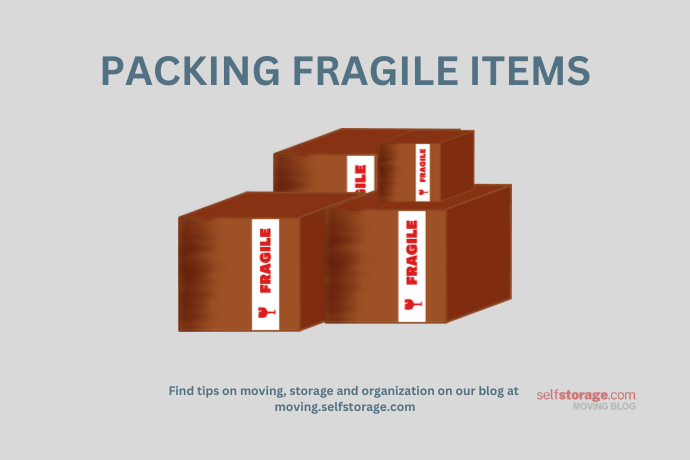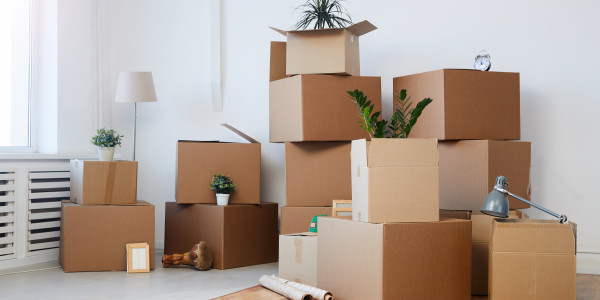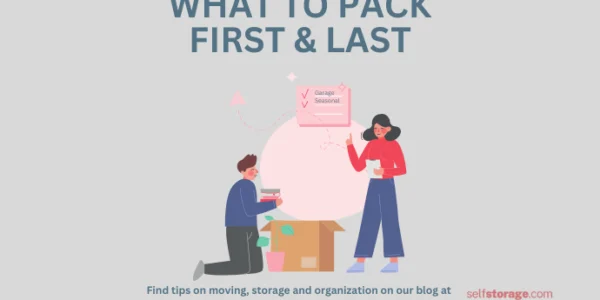What’s covered in this article – click on a link to learn more:
- Why Fragile Packing Matters
- Gather the Right Packing Supplies
- How To Prepare Fragile Items for Packing
- How To Wrap and Pad Fragile Items
- How To Layer and Nest Fragile Items
- Label and Identify Fragile Boxes
- How To Secure and Seal Fragile Boxes
- Packing Fragile Boxes on a Moving Truck
You’re in your living room, boxes everywhere. On the table sits your grandmother’s china set. Each piece, from the fragile teacups to the elaborate serving dish, tells a story of shared family moments. You’re staring at them because you now need to pack them for a cross-country move. I mean, they’re not just plates and cups; they’re memories. And they need to be safe. As does your antique furniture, your delicate glassware or a family heirloom.
Don’t sweat it, we’ve put together a doable guide with the best and easiest ways to safely stow your cherished and delicate belongings. Whether you’re new to packing or just need some extra help figuring out how to pack fragile items for moving, these tips can make it all smoother and worry-free.
After all, it’s proper fragile packing that keeps your special things safe from breaking, chipping or scratching until they make it all the way to your new home. That and communicating well with movers or helpers.
Why Fragile Packing Matters
You can stuff suitcases with clothes and just stack books in a cardboard box, but that won’t work for any of your fragile items. Actually, books are often damaged during a move, so you should pay extra care to them too — not so much with bubble wrap but keeping them safe from spills or becoming warped. This is what you risk with improper fragile packing:
- Items bumping against each other in the box/truck
- Shock damage from dropping or even rough handling
- Stress on fragile parts during transit
Now, you can prevent common moving woes like broken glass, chipped porcelain or scratches by taking a few extra steps to carefully pack each fragile item. This also reduces the risk of losing parts of valuable sets or irreplaceable items.
Feeling like you’d have a better use for all that time spent fragile packing? Just remember that these items often have more than just a price tag — they hold memories and history. You wouldn’t want anything bad happening to them just because you or the movers were in a rush.
Gather the Right Packing Supplies
When it’s time to pack up those fragile items, having the right tools makes all the difference. These are the most common packing supplies for fragile items you’re going to need:
- Sturdy boxes. Different sizes for different items. Smaller boxes are best for heavy items like books or glassware to prevent overpacking. Yes, that’s a thing — a very common mistake, in fact.
- Bubble wrap. This is the absolute go-to for cushioning. Wrap individual fragile items to protect them from shocks and bumps. There’s no such thing as too much bubble wrap.
- Packing paper. Cleaner than newspaper, it does a great job of protecting surfaces and filling gaps in boxes.
- Packing tape. Now that’s a strong tape to securely seal your boxes. Don’t skimp here — a box coming apart is the last thing you need.
- Cushioning materials. Foam peanuts or even crumpled paper can fill spaces in boxes to prevent items from moving around.
How To Prepare Fragile Items for Packing
A little time spent preparing can save a lot of trouble later, so here’s a table that will come in handy in the fragile packing prep stage. This way, you can see all the steps clearly.
| Step | Action | Details | Why It Matters |
| Clean and dry | Gently clean each item. Ensure everything is dry. | Dust off décor and wipe down glass items. | Dust and moisture can cause damage during the move. |
| Disassemble | Take apart larger items if possible. | Remove lampshades, detach glass from frames, separate parts. | Smaller pieces are easier to pack and less likely to get damaged. |
| Remove fragile components | Take out light bulbs, glass shelves and delicate parts. | Focus on items from furniture and electronics. | These components are often the most vulnerable to damage. |
| Organize and inventory | Group similar items. | Make a list or take photos. | Ensures easy unpacking and that nothing is forgotten. |
Pro tip: When you remove parts or disassemble items, keep screws and small components in a labeled bag. Tape it to the larger part of the item or keep all such bags in one box labeled “Assembly Parts.”
How To Wrap and Pad Fragile Items
To pad the boxes, start with a soft layer of packing paper or foam sheet, then add a layer of bubble wrap for extra protection. Wrap fragile items securely, but not too tightly. You want to cushion them, not put pressure on delicate parts.
Using the right mix of packing materials will go a long way. Here’s a quick breakdown for fragile packing:
- Bubble wrap. Great for shock absorption. For maximum protection, wrap it with the bubble side facing the item.
- Packing paper. It’s soft and prevents scratches, which makes it perfect for a first layer or to fill gaps.
- Foam sheets. This cushioned barrier goes best between stacked plates or screens.
- Packing peanuts. Use them to fill in the extra space in boxes, keeping fragile items from shifting during the move.
Note that each item should get its own wrapping session, especially if it’s highly fragile. After wrapping, place the item in the box to test the fit. Adjust the padding as needed until the item no longer moves in the box but without squeezing it at all. Use extra paper or foam to fill any gaps in the box.
Fragile Packing and Wrapping Checklist
- A soft layer of packing paper
- Bubble wrap for extra cushioning
- Secure but gentle wrapping
- Fill gaps with additional padding
How To Layer and Nest Fragile Items
Start the layering process by laying a soft foundation in the box with packing paper or foam. Layer strategically, placing heavier items at the bottom and lighter, more delicate items on top, always with a cushioning layer of paper or bubble wrap in between.
Got similar items like a set of glass or ceramic bowls? Use nesting instead of layering. After wrapping each piece, place the smaller item inside the larger one and make sure there’s soft padding between each nested item — they shouldn’t touch directly.
Techniques aside, these quick tips for fragile packing may also come in handy:
- Stuff hollow items like vases or glasses with packing paper.
- Use packing peanuts or crumpled paper to fill any gaps in the box. I know I’ve said this before but knowing how easy it is to overlook this, I may not be saying it enough.
- Avoid overloading boxes. Heavy boxes are hard to move and much more prone to falling apart.
Label and Identify Fragile Boxes
By properly labeling your fragile package, you give a heads-up to everyone who handles it. Clear labels communicate to movers, helpers and even to you later, the need for extra care. This reduces the risk of careless handling and accidents.
Here’s how to label a fragile package or box:
- Write “Fragile” or “Handle with Care” on each side of the box. Don’t forget the top and bottom! Handling isn’t always front-facing. Make it bold and visible, by using a thick marker and large letters.
- Besides words, it wouldn’t hurt to use universal symbols like a broken glass or a sticker with two hands surrounding a box (both symbols indicate delicate handling).
- Use brightly colored labels or tape, like red or orange, to catch the eye of whoever handles the box. Stick to the same color or symbol for all fragile items. It makes identification easier during the hectic moving process.

Pro tip: If you’re using a moving company, check if they have specific labeling guidelines or provide labels.
How To Secure and Seal Fragile Boxes
Securing and sealing your boxes is the final checkpoint before they’re ready to go. What you have to do is tape them right and reinforce the edges.
Use strong, high-quality packing tape to seal the top and bottom seams of the box and extend the tape well beyond the seams for extra hold. Don’t just go once around — a couple of layers add notable strength.
Pay special attention to corners and edges because they are high-stress areas. Better yet, consider using corner protectors — they add an extra layer of armor against knocks and bumps.
Once sealed, give your box a gentle shake. If you hear movement, it might need more padding.
Pro tip: Label the boxes as “Sealed” or “Ready” after checking them. It helps keep track of which boxes are completely packed and secured.
Packing Fragile Boxes on a Moving Truck
Getting your fragile boxes from point A to point B safely goes beyond packing. As a rule of thumb, you should pack fragile boxes in the moving truck last. This way, they’ll be the first to come out when reaching the destination, reducing handling time and risk. Position boxes so they won’t slide around. Use the flat, stable surfaces of furniture or heavier boxes as a base, and never stack heavy items on top of boxes marked as fragile.
Next, you want to secure the boxes in the moving truck, using straps or bungee cords to prevent any movement during transit. Are there gaps around the boxes? Fill them with soft items like blankets or pillows to keep them from shifting.
Let everyone involved in the move know which boxes contain fragile items and require extra care. Once again, make sure that your “Fragile” labels are visible and clear to anyone handling the boxes.
Pro tip: If you’re the one driving the moving vehicle, turn and brake gently to minimize jostling. On longer trips, check periodically to ensure that everything is holding up and nothing has shifted.
You Are Now a Fragile Packing Pro
Feeling more confident about moving your fragile items across the country? Just a quick recap, if you don’t mind, to make sure everything is clear.
Prepare the items and get sturdy boxes, bubble wrap, packing paper and all sorts of cushioning materials. These packing supplies for fragile items, combined with proper layering and nesting techniques will help secure your precious cargo no matter the distance. Don’t forget about secure wrapping, padding and clear labeling. Last, but not least, load fragile packages last and stabilize them in the van with cords and blankets.
There you have it! You now know how to pack fragile items for moving unscathed and ready to add new memories to your new home.





